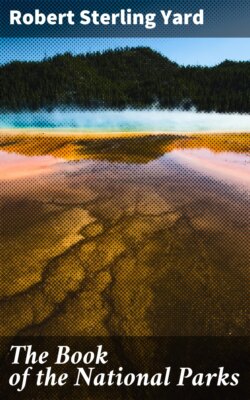Читать книгу The Book of the National Parks - Robert Sterling Yard - Страница 11
На сайте Литреса книга снята с продажи.
I
ОглавлениеThe starting point for any consideration of our national parks necessarily is the recently realized fact of their supremacy in world scenery. It was the sensational force of this realization which intensely attracted public attention at the outset of the new movement; many thousands hastened to see these wonders, and their reports spread the tidings throughout the land and gave the movement its increasing impetus.
The simple facts are these:
The Swiss Alps, except for several unmatchable individual features, are excelled in beauty, sublimity and variety by several of our own national parks, and these same parks possess other distinguished individual features unrepresented in kind or splendor in the Alps.
The Canadian Rockies are more than matched in rich coloring by our Glacier National Park. Glacier is the Canadian Rockies done in Grand Canyon colors. It has no peer.
The Yellowstone outranks by far any similar volcanic area in the world. It contains more and greater geysers than all the rest of the world together; the next in rank are divided between Iceland and New Zealand. Its famous canyon is alone of its quality of beauty. Except for portions of the African jungle, the Yellowstone is probably the most populated wild animal area in the world, and its wild animals are comparatively fearless, even sometimes friendly.
Mount Rainier has a single-peak glacier system whose equal has not yet been discovered. Twenty-eight living glaciers, some of them very large, spread, octopus-like, from its centre. It is four hours by rail or motor from Tacoma.
Crater Lake is the deepest and bluest accessible lake in the world, occupying the hole left after one of our largest volcanoes had slipped back into earth's interior through its own rim.
GENERAL GRANT TREE It has a National Park all to itself
Yosemite possesses a valley whose compelling beauty the world acknowledges as supreme. The valley is the centre of eleven hundred square miles of high altitude wilderness.
The Sequoia contains more than a million sequoia trees, twelve thousand of which are more than ten feet in diameter, and some of which are the largest and oldest living things in the wide world.
The Grand Canyon of Arizona is by far the hugest and noblest example of erosion in the world. It is gorgeously carved and colored. In sheer sublimity it offers an unequalled spectacle.
Mount McKinley stands more than 20,000 feet above sea level, and 17,000 feet above the surrounding valleys. Scenically, it is the world's loftiest mountain, for the monsters of the Andes and the Himalayas which surpass it in altitude can be viewed closely only from valleys from five to ten thousand feet higher than McKinley's northern valleys.
The Hawaii National Park contains the fourth greatest dead crater in the world, the hugest living volcano, and the Kilauea Lake of Fire, which is unique and draws visitors from the world's four quarters.
These are the principal features of America's world supremacy. They are incidental to a system of scenic wildernesses which in combined area as well as variety exceed the combined scenic wilderness playgrounds of similar class comfortably accessible elsewhere. No wonder, then, that the American public is overjoyed with its recently realized treasure, and that the Government looks confidently to the rapid development of its new-found economic asset. The American public has discovered America, and no one who knows the American public doubts for a moment what it will do with it.
